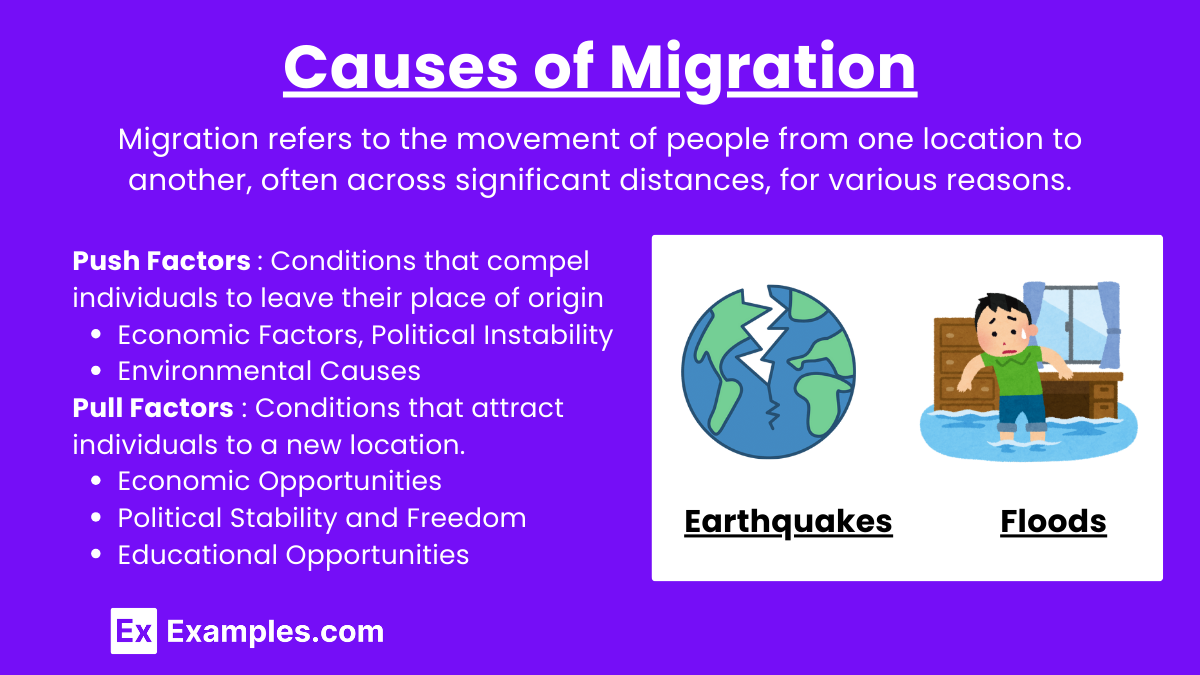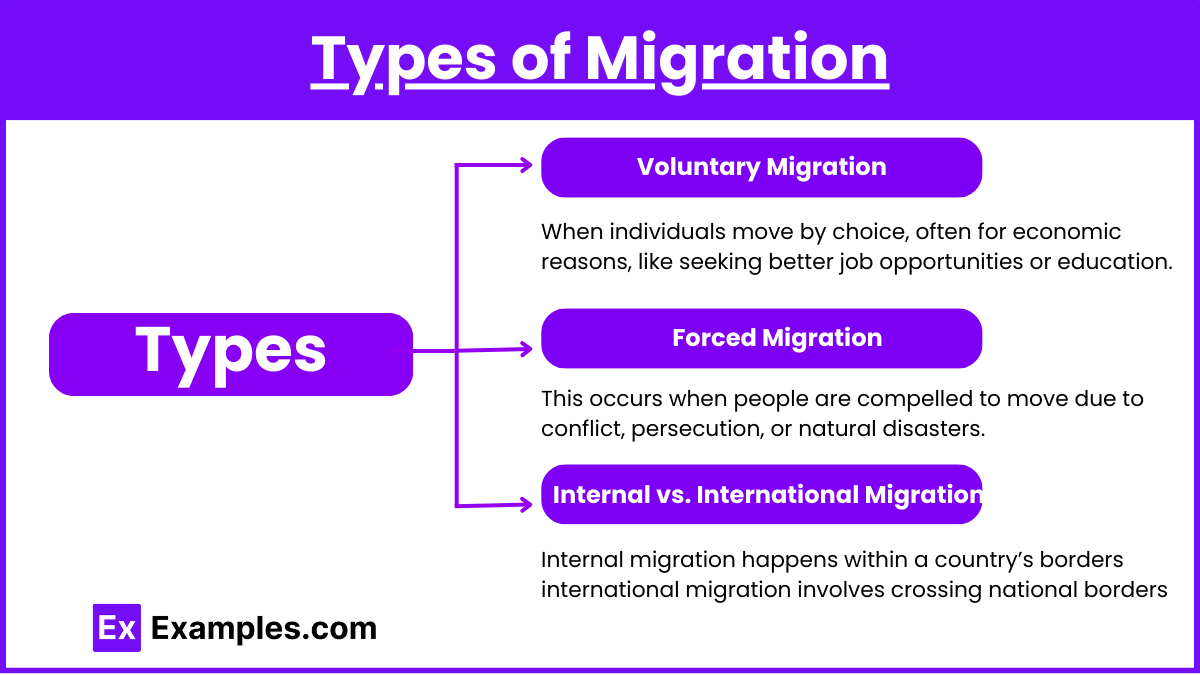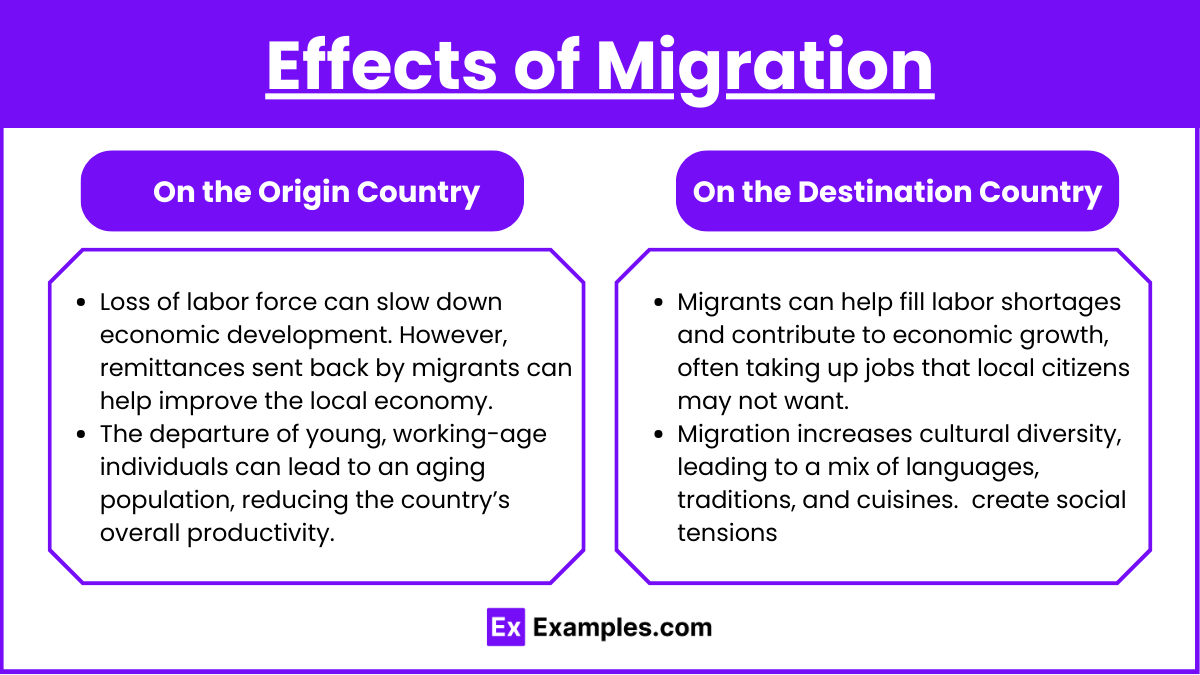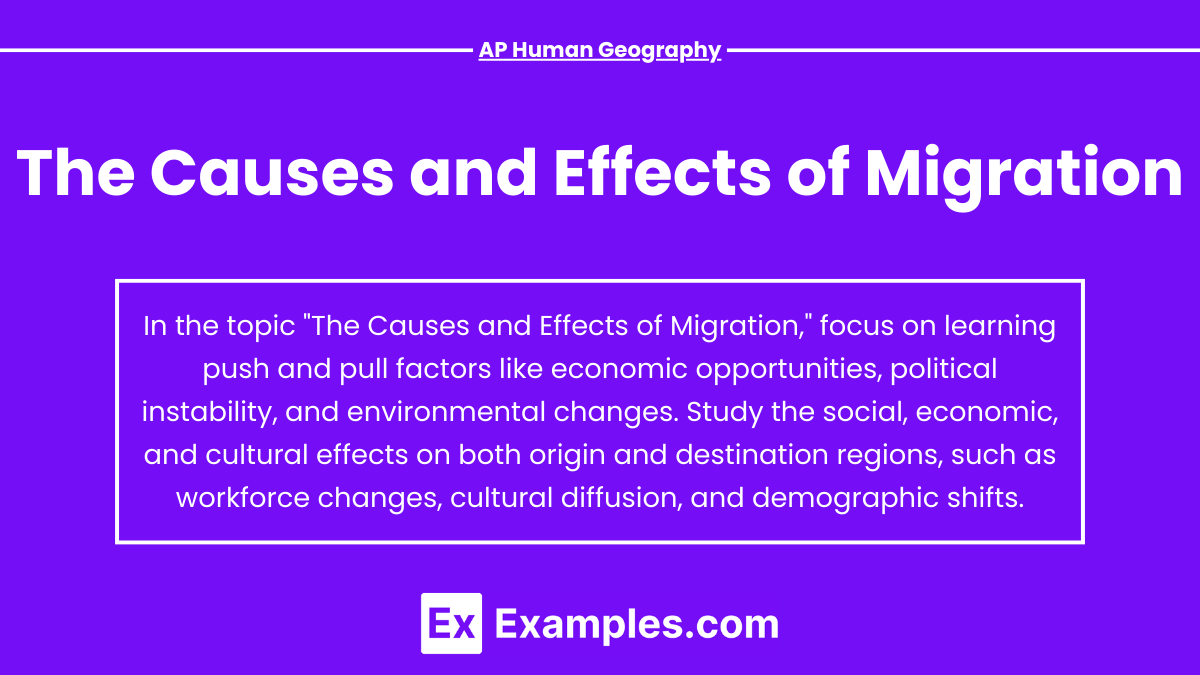Migration, a key topic in AP Human Geography, refers to the movement of people from one place to another due to a combination of push and pull factors. Push factors, such as economic hardship, political instability, or environmental disasters, compel people to leave their homeland. Pull factors, including better job opportunities, political stability, or family reunification, attract people to new destinations. Migration has significant effects on both origin and destination countries, impacting their economies, demographics, and cultures, while also affecting migrants themselves.
Learning Objectives
In studying “The Causes and Effects of Migration” for AP Human Geography, you will identify and analyze the various factors that drive migration, including economic, social, political, and environmental influences. You will evaluate how migration patterns impact both the originating and receiving regions, examining demographic changes, cultural interactions, and economic effects. Additionally, you will explore the consequences of migration on social structures, public policies, and global interconnectedness. Ultimately, you will develop a comprehensive understanding of the complex relationships between migration causes and their far-reaching effects.
The Causes and Effects of Migration for AP Human Geography
Causes of Migration

Migration refers to the movement of people from one location to another, often across significant distances, for various reasons. Migration is typically driven by a combination of “push” and “pull” factors:
- Push Factors: These are conditions that compel individuals to leave their place of origin. They include:
- Economic Factors: Lack of job opportunities, poverty, or economic downturns often push people to migrate in search of better livelihoods.
- Political Instability: Wars, conflict, political repression, or authoritarian regimes can force people to flee their country in search of safety.
- Environmental Causes: Natural disasters such as earthquakes, floods, droughts, and climate change-related issues can push populations to migrate. For example, rising sea levels might displace coastal communities.
- Social/Cultural Factors: Discrimination, religious persecution, or a lack of access to essential services (e.g., education and healthcare) can lead people to migrate.
- Pull Factors: These are conditions that attract individuals to a new location. They include:
- Economic Opportunities: Higher wages, job availability, and better living standards are major pull factors. Countries with strong economies, like the U.S. or Germany, often attract migrants seeking employment.
- Political Stability and Freedom: Countries with stable governments, political freedom, and democratic processes attract people from less stable regions.
- Educational Opportunities: Some migrants seek better education for themselves or their children, which drives them to countries with high-quality educational systems.
- Family Reunification: Many individuals migrate to reunite with family members who have already settled in a different country.
Types of Migration

- Voluntary Migration: When individuals move by choice, often for economic reasons, like seeking better job opportunities or education.
- Forced Migration: This occurs when people are compelled to move due to conflict, persecution, or natural disasters. Refugees and internally displaced persons (IDPs) are examples of forced migrants.
- Internal vs. International Migration: Internal migration happens within a country’s borders (e.g., rural to urban migration), while international migration involves crossing national borders.
Effects of Migration

On the Origin Country:
- Loss of labor force can slow down economic development. However, remittances sent back by migrants can help improve the local economy.
- The departure of young, working-age individuals can lead to an aging population, reducing the country’s overall productivity.
- The emigration of highly skilled or educated individuals (brain drain) can weaken sectors like healthcare and education in the origin country.
On the Destination Country:
- Migrants can help fill labor shortages and contribute to economic growth, often taking up jobs that local citizens may not want. However, rapid immigration may strain public services.
- Migration increases cultural diversity, leading to a mix of languages, traditions, and cuisines. While this enhances cultural exchange, it may also create social tensions if integration challenges arise.
- A large influx of migrants can put pressure on public services such as healthcare, education, and housing, leading to policy challenges for governments.
Examples
Example 1: Syrian Civil War (Push Factor: Political Instability)
The ongoing civil war in Syria, which began in 2011, has displaced millions of people due to violence, persecution, and destruction of infrastructure. Political instability and constant threats from armed conflict have forced Syrians to seek refuge in neighboring countries like Turkey, Lebanon, and Jordan, and further into Europe. This mass forced migration has overwhelmed the resources of host nations, leading to humanitarian crises and increased political tensions in Europe over immigration policies.
Example 2: Mexican Migration to the U.S. (Pull Factor: Economic Opportunities)
A significant wave of migration from Mexico to the United States has been fueled by economic disparities. Many Mexicans migrate to the U.S. in search of higher-paying jobs and better living conditions. This voluntary migration has led to remittances being sent back to Mexico, improving local economies in migrant-origin areas. However, the U.S. has experienced debates over immigration policies, job competition, and the strain on social services due to this influx of labor.
Example 3: Hurricane Katrina (Push Factor: Environmental Disaster)
In 2005, Hurricane Katrina caused massive destruction along the Gulf Coast, particularly in New Orleans. Thousands of people were displaced due to the flooding and destruction of homes. This environmental disaster pushed individuals to migrate internally within the U.S. to neighboring states. The effects included demographic shifts, with displaced residents settling permanently in areas like Texas, and challenges in rebuilding the economic infrastructure of New Orleans.
Example 4: Indian IT Professionals to Silicon Valley (Pull Factor: Technological and Educational Opportunities)
Many skilled IT professionals from India have migrated to the U.S., particularly to Silicon Valley, due to the booming technology sector. The U.S. offers better job opportunities, higher salaries, and a conducive environment for career growth in tech industries. This migration has benefited the U.S. economy through the contribution of skilled labor but has also led to brain drain in India, where the departure of these highly skilled workers has weakened local industries.
Example 5: Rohingya Refugees in Bangladesh (Push Factor: Religious Persecution)
The Rohingya, a Muslim minority group in Myanmar, have faced violent persecution from the Buddhist-majority government, forcing over 700,000 to flee to Bangladesh. This forced migration was driven by religious persecution and ethnic cleansing. The sudden influx of refugees has strained Bangladesh’s resources, creating overcrowded camps, health crises, and long-term economic and social pressures on the host country.
Multiple Choice Questions
Question 1
Which of the following is a primary push factor that causes people to migrate?
A) Job opportunities in a foreign country
B) Political instability and conflict in the home country
C) Higher wages in another country
D) A strong educational system in another country
Answer: B) Political instability and conflict in the home country
Explanation: Push factors are the conditions in the home country that compel individuals to leave, and political instability and conflict are key examples of push factors. People often flee their countries due to unsafe conditions, such as war or government persecution. While job opportunities and higher wages (choices A and C) are pull factors, meaning they attract individuals to a new destination, political instability (B) is a direct push factor driving people away from their homeland.
Question 2
Which of the following is an economic effect of migration on the destination country?
A) Increased pressure on housing and social services
B) Decreased cultural diversity
C) An aging population due to emigration
D) Higher population growth in rural areas
Answer: A) Increased pressure on housing and social services
Explanation: When migrants move to a new country, they often place additional demands on housing, healthcare, and education services. This is particularly true if migration happens rapidly, overwhelming the infrastructure of the destination country. Option C refers to the origin country, where an aging population can result from emigration. Option B is incorrect because migration generally increases cultural diversity. Option D does not directly relate to the economic effects of migration.
Question 3
Which of the following best describes the term brain drain in the context of migration?
A) Migrants moving to rural areas for agricultural jobs
B) Migrants sending money back to their home country
C) The emigration of highly skilled or educated individuals from their home country
D) The spread of cultural ideas from one country to another through migration
Answer: C) The emigration of highly skilled or educated individuals from their home country
Explanation: Brain drain occurs when highly educated or skilled individuals leave their home country, typically seeking better opportunities abroad. This can negatively impact the origin country by depleting it of vital human capital, such as doctors, engineers, and scientists. Option B refers to remittances, and option D refers to cultural diffusion, both of which are different from the concept of brain drain.


